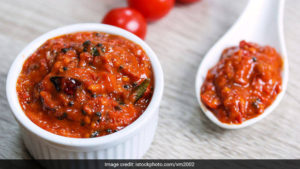Move Aside Mango Pickle, Time to Indulge in Meat (Non-Vegetarian) Pickles
By Plavaneeta Borah – NDTV
Undeniably, pickle or achaar is the most favorite condiment in Indian cuisine. There are so many different lip-smacking options to choose from that meal time in an Indian household is never dull or short on flavor. While there are many ingredients that go into the making of regional Indian pickles, mango pickle or Aam ka Achaar is most loved all across the sub-continent. But pickle making in India doesn’t just stop at fruits and veggies. The meat lovers too use this ancient technique to make irresistible non-vegetarian variants.
Travel to the Northeastern states of India, and you are bound to come across meat pickles in local homes, restaurants and even roadside eateries. Those glistening bottles of tempting flavors also preserve the love that go into their making, which is why the locals value them dearly. Be it the Khasi smoked pork pickle or Nagaland’s shredded beef pickle with king chilli flakes, they are an absolute treat for meat lovers. Then there are many variations too – pork pickle with bamboo shoot, beef pickle with bhoot jolokia, dried fish pickle with chillies, among other delicious options. Team them with rice, rotis or munch as snacks, they are instant flavor boosters.
In the South too, non-vegetarian pickles are highly sought after. The twin cities of Hyderabad and Secunderabad are known for selling achaar with a distinct Andhra taste. From Mir Alam Mandi and Chowk near the historic Charminar to Nampally, one finds many shops selling achaar and other condiments. Gosht ka Achaar and Chicken Achaar made with regional ingredients like gongura, Guntar chilies and other flavorful spices are devouring.
Kerala’s love for meat is well known, be it fish, beef or mutton, and hence finding non-vegetarian pickles comes as no surprise. The Syrian Christians particularly prepare fish and beef pickles that are loaded with masalas. The Kodavas of Coorg and the Mangaloreans also prepare non-vegetarian pickles, pork and fish (Bombay Duck pickle) respectively.
Coming to Goa, the Catholics are famous for their pickles like Prawn Balchao, which is often relished with a plate of steamed rice and fish curry. The Parsis prepare a variety of fish pickles using different pickle bases. Rajasthan is also known for its various non-vegetarian dishes, which were originally prepared from gamy meat like wild boar or deer. Now, tender mutton is the preferred choice of meat, and as such it is also used to make pickles.
While vinegar is a common ingredient that goes into pickle making, some also like to use other variants like Kolah vinegar, toddy, barley water, and brine. Most of these pickles have a limited shelf-life as they are home-made. The smoked meat variants usually last longer as they are devoid of moisture. Hence they do not require excessive dousing of oil.


